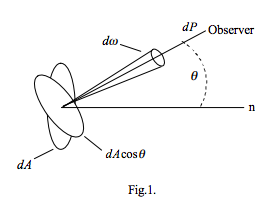1.2: Radiance and the Equation of Transfer
- Page ID
- 7490
Radiance may be regarded as the fundamental quantity of radiative transfer.

Consider, as shown in figure 1, an emitting (or reflecting) surface of area dA which emits dP watts of power into solid angle dω about the direction of an observer at angle θ to the surface normal vector n of dA, the latter presenting a projected area dAcosθ to the observer. The radiance detected by the observer is then
\[L=\frac{d P}{d \omega d A \cos \theta}\]
Radiance then has the following properties:
It is defined at a point and in a specified direction.
It is independent of the distance from which it is observed
Its SI units are watts per square metre per steradian (W m-2 sr-1). This can be interpreted in either of two ways. Either, it is the power projected into unit solid angle from unit projected area of an extended surface (i.e. projected on a plane at right angles to the line of sight from the observer); or it is the power arriving per unit area at the observer from unit solid angle (subtended at the observer) of the extended source. That these are equivalent is shown in reference (2).
If radiance is the fundamental quantity of radiative transfer, then the fundamental law is the equation of transfer
\[-\frac{d L}{\kappa \rho d s}=L-\mathfrak{J}.\]
Here \(\frac{d L}{d s}\) is the rate of change of radiance with, and in the direction of, position s in a given medium, r is the density of the medium (kg m-3) and κ is the mass attenuation coefficient (m2 kg-1). Here attenuation refers to any process which reduces the brightness of a beam of radiation, and so includes absorption and scattering. Some authors use the word extinction for attenuation, and some (particularly in the field of stellar atmospheres) use the word opacity to refer to the mass attenuation coefficient.
Equation (2) could be read as follows: as a beam of radiance L traverses the distance d s it will be diminished in radiance by the amount krLd s and enhanced by the amount \(\kappa \rho \mathfrak{J} \delta s\). The quantity \(\mathfrak{J}\) is called the source function and, as we shall see, a typical problem of planetary photometry is to find a solution for this quantity before solving the equation of transfer as a whole.


